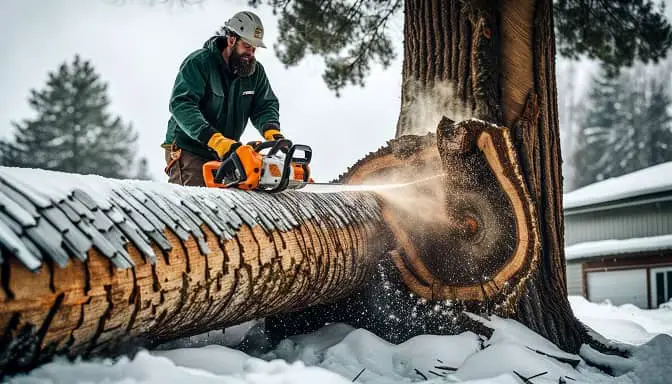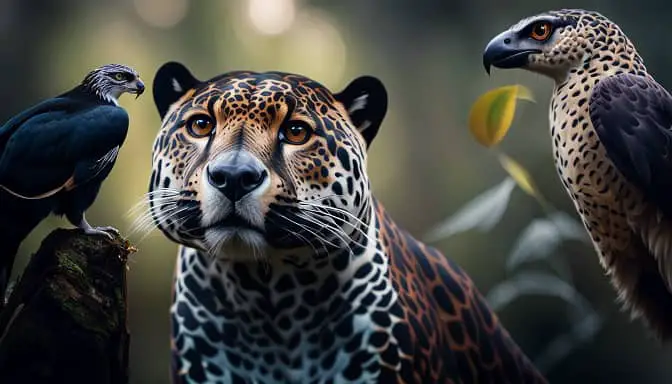
This article links deforestation and loss of biodiversity to human life. See how they are interconnected in this analysis of how deforestation impacts on human society.
Table of Contents
Introduction
Deforestation is a pressing issue that has significant consequences for biodiversity. It refers to the clearing, removal, or destruction of forests, resulting in the loss of trees and vegetation. This widespread practice has a profound impact on the delicate balance of ecosystems and the diverse range of species that inhabit them.
The effects of deforestation on biodiversity are far-reaching. When forests are cleared, countless animal and plant species lose their natural habitats. This disruption can lead to the extinction of species, as they struggle to adapt to new environments or face increased competition for limited resources. Additionally, deforestation disrupts the intricate web of interactions between species, such as pollination and seed dispersal, which are vital for the survival and reproduction of many organisms.
Furthermore, deforestation contributes to the loss of genetic diversity within species. As populations become fragmented and isolated, their ability to adapt to changing environmental conditions diminishes. This reduces their resilience to threats such as disease outbreaks or climate change.
The consequences of deforestation extend beyond the realm of biodiversity. Forests play a crucial role in regulating the climate by absorbing carbon dioxide, a greenhouse gas that contributes to global warming. When forests are cleared, this natural carbon sink is diminished, leading to increased greenhouse gas emissions and exacerbating climate change.
In the following sections, we will explore specific cases of deforestation and loss of biodiversity, as well as the impact of biodiversity loss on human life. Understanding these issues is crucial in order to develop effective strategies to address the challenges posed by man-made deforestation.
Cases of Deforestation and Loss of Biodiversity
Deforestation is a global issue that affects both temperate and tropical countries, leading to the loss of biodiversity and the disruption of ecosystems. In this section, we will explore two specific cases of deforestation, one in a temperate country and one in a tropical country, highlighting the impact on specific animal species and the response from government and non-government organizations.
Deforestation in Temperate Countries
In temperate countries, one notable case of deforestation and its impact on biodiversity is the logging of old-growth forests in the Pacific Northwest of the United States. These forests are home to a diverse range of species, including the iconic Northern Spotted Owl.

The logging activities have resulted in the loss of habitat for the Northern Spotted Owl, pushing the species to the brink of extinction. The destruction of these forests also affects other species, such as the Marbled Murrelet, a seabird that relies on old-growth trees for nesting. The loss of these habitats has had a cascading effect on the entire ecosystem, disrupting the natural balance and leading to a decline in biodiversity.
Response to the Threat of Biodiversity Loss
To address the threat of biodiversity loss in the Pacific Northwest, both government and non-government organizations have taken action. The U.S. Fish and Wildlife Service designated critical habitat areas for the Northern Spotted Owl, providing legal protection for these areas and promoting habitat restoration efforts.
Additionally, conservation organizations such as the Audubon Society and the Sierra Club have been actively involved in raising awareness about the importance of old-growth forests and advocating for their preservation. These organizations have conducted research, engaged in public outreach, and collaborated with policymakers to develop sustainable forestry practices that prioritize biodiversity conservation.
Deforestation in Tropical Countries
In tropical countries, the Amazon rainforest stands as a prominent example of deforestation and its impact on biodiversity. The Amazon is home to countless species, including the jaguar, the giant river otter, and the harpy eagle.

However, the expansion of agriculture, particularly for soybean and cattle production, has led to widespread deforestation in the region. This has resulted in the loss of habitat for these iconic species, pushing them towards extinction.
The destruction of the Amazon rainforest also disrupts the intricate web of interactions between species, affecting pollination, seed dispersal, and nutrient cycling processes.
Response to the Threat to Loss of Biodiversity
The response to the threat of biodiversity loss in the Amazon has been multifaceted. Governments in the region, such as Brazil, have implemented policies and regulations to curb deforestation, including the establishment of protected areas and the enforcement of environmental laws. Non-government organizations, such as the Amazon Environmental Research Institute (IPAM) and the World Wildlife Fund (WWF), have been actively involved in monitoring deforestation rates, conducting research on the impacts of deforestation, and working with local communities to promote sustainable land use practices. These organizations also collaborate with international partners to raise awareness and advocate for the conservation of the Amazon rainforest.
Deforestation poses a significant threat to biodiversity in both temperate and tropical countries as these cases exemplify. The logging of old-growth forests in temperate regions, such as the Pacific Northwest, has led to the loss of habitat for species like the Northern Spotted Owl.
In tropical countries like Brazil, the destruction of the Amazon rainforest has resulted in the decline of iconic species like the jaguar. However, government and non-government organizations have responded to these threats by implementing policies, conducting research, and advocating for sustainable land use practices. It is crucial that these efforts continue and expand to ensure the preservation of biodiversity and the protection of our natural ecosystems.
The Impact of Biodiversity Loss to Human Life
Loss of biodiversity has far-reaching consequences for human life, affecting various aspects such as food security, human health, economy, resilience against climate change, medicine, ecological support, and disease control. Each of these effects is interconnected and plays a crucial role in maintaining a sustainable and thriving society.
Food security is threatened
One of the most significant impacts of biodiversity loss is on food security. Biodiversity provides the foundation for a diverse and resilient food system. The loss of plant and animal species reduces the genetic diversity of crops and livestock, making them more susceptible to diseases and pests. This vulnerability threatens the stability of our food production and can lead to crop failures and food shortages.
Additionally, the loss of pollinators, such as bees and butterflies, hampers the pollination process, which is essential for the reproduction of many fruits, vegetables, and nuts. Without a diverse range of pollinators, our food supply would be severely compromised.
Human health is compromised
Human health is also greatly affected by biodiversity loss. Many of the medicines we rely on are derived from plants and animals. As species disappear, so does the potential for discovering new drugs and treatments. Biodiversity loss limits our ability to find natural remedies for various diseases and ailments.
Furthermore, the destruction of natural habitats increases the risk of zoonotic diseases, which are transmitted from animals to humans. Examples of zoonotic diseases include Ebola, SARS, and COVID-19. When we disrupt ecosystems and come into closer contact with wildlife, the chances of these diseases spilling over into human populations increase.
Economic losses and job insecurity
The economy is another area impacted by biodiversity loss. Many industries, such as agriculture, forestry, and tourism, depend on healthy ecosystems and diverse species. The decline of biodiversity can lead to economic losses and job insecurity.
For example, the fishing industry relies on healthy marine ecosystems and diverse fish populations. Overfishing and habitat destruction have already led to the collapse of several fish stocks, resulting in the loss of livelihoods for fishermen and economic instability for coastal communities.
Similarly, the tourism industry relies on intact ecosystems and diverse wildlife to attract visitors. If these ecosystems are degraded or species disappear, tourism revenues decline, affecting local economies.
Undermines resilience against climate change
Biodiversity loss also undermines our resilience against climate change. Healthy ecosystems, such as forests and wetlands, act as natural buffers against extreme weather events, such as floods and droughts.
Forests absorb and store carbon dioxide, helping to mitigate climate change. When these ecosystems are destroyed or degraded, their ability to provide these services is compromised. This makes communities more vulnerable to the impacts of climate change, such as increased flooding, heatwaves, and food insecurity.
Disrupts the ecological support systems
Furthermore, biodiversity loss disrupts the ecological support systems that sustain life on Earth. Ecosystems provide essential services, such as water purification, soil fertility, and nutrient cycling.
When biodiversity declines, these services are compromised, leading to degraded water quality, reduced soil productivity, and imbalances in nutrient cycles. These disruptions have cascading effects on human well-being, affecting our access to clean water, agricultural productivity, and overall ecosystem health.
Disease control is affected
Disease control is also impacted by biodiversity loss. Biodiversity plays a crucial role in regulating disease transmission. Healthy ecosystems help to control the populations of disease-carrying organisms, such as mosquitoes and ticks.
When biodiversity declines, these populations can increase, leading to a higher risk of disease outbreaks. Additionally, the loss of biodiversity can disrupt the natural predators and competitors of disease-carrying organisms, further exacerbating the spread of diseases.
In summary, the loss of biodiversity has profound impacts on human life. It affects food security, human health, economy, resilience against climate change, medicine, ecological support systems, disease control, and other important concerns.
Recognizing the interconnectedness of these effects is crucial for understanding the urgency of biodiversity conservation and the need for sustainable practices that protect and restore our natural ecosystems. By prioritizing biodiversity conservation, we can safeguard our own well-being and ensure a sustainable future for generations to come.
How Individuals Should Respond to the Effects of Man-Made Deforestation
To address the effects of man-made deforestation on biodiversity, individuals can take several actions at the individual level. Here are five of the most relevant actions that individuals can implement:
- Support Sustainable Agriculture: Choose to buy organic and locally sourced food products. By doing so, individuals can support farming practices that prioritize biodiversity conservation, such as agroforestry and regenerative agriculture. These practices promote the integration of trees and diverse crops, which helps to restore habitats and protect wildlife.
- Reduce Consumption of Animal Products: Animal agriculture is a major driver of deforestation, particularly in regions like the Amazon rainforest. By reducing the consumption of meat and dairy products, individuals can help reduce the demand for deforestation-linked commodities like soy and beef. Opting for plant-based alternatives or adopting a flexitarian or vegetarian diet can significantly reduce an individual’s ecological footprint.
- Plant Native Trees and Plants: Individuals can contribute to reforestation efforts by planting native trees and plants in their gardens or local green spaces. Native species are better adapted to the local ecosystem and provide essential habitats for wildlife. Planting trees also helps to sequester carbon dioxide, mitigating climate change impacts.
- Support Conservation Organizations: Individuals can contribute to the protection of biodiversity by supporting local and international conservation organizations. Donating funds, volunteering, or participating in citizen science projects can make a significant difference in preserving and restoring ecosystems.
- Advocate for Policy Change: Individuals can use their voices to advocate for stronger environmental policies and regulations. This can be done by contacting elected officials, signing petitions, participating in public consultations, or joining environmental advocacy groups. By raising awareness and pushing for change, individuals can help create a more sustainable and biodiverse future.
By taking these actions, individuals can play a crucial role in mitigating the effects of man-made deforestation on biodiversity. Each individual effort contributes to the collective goal of preserving our natural ecosystems and ensuring a sustainable future for all.
Conclusion
To conclude, it is imperative that we take immediate action to counter deforestation and the subsequent loss of biodiversity. The devastating effects of man-made deforestation on our planet cannot be ignored any longer. By implementing the following actions, we can make a significant difference in preserving our natural ecosystems and ensuring a sustainable future for all.
The urgent need to counter deforestation and the loss of biodiversity cannot be overstated. By taking these actions at the individual level, we can collectively work towards a more sustainable and biodiverse future.
Let us act now to protect our planet and ensure the well-being of future generations.


